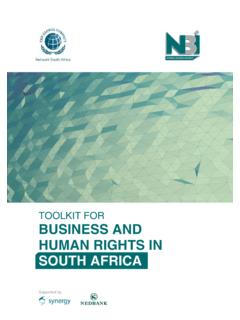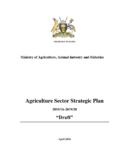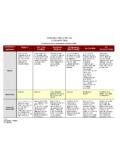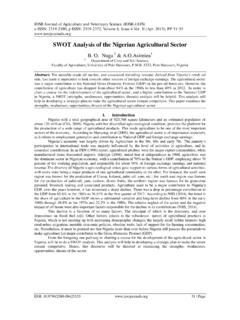Transcription of What is Fair Trade?
1 1 What is fair trade ? fair trade is a lot of things: a social justice movement, an alternative business model, a s y s t e m o f g l o b a l c o m m e r c e , a t o o l f o r international development, a faith-based activity. It means different things to different p e o p l e . T h e r e i s n o s i n gl e , r e g ul a t o r y , authoritative body. So, individuals need to explore various models and concepts. fair trade s many definitions do always center around the exchange of goods based on principles of economic and social justice. Every business transaction is a challenge to see that both parties come out fairly. Adam Smith, 1759 Credit: Global Exchange Swaziland artisan at work on the loom A Useful Definition of fair trade In 1998, four European organizations created a widely accepted definition of fair trade .
2 Fairtrade Labeling Organizations ( now Fairtrade Interna-tional, FI) , International fair trade Association ( now World fair trade Organization, WFTO), the Network of European Worldshops (NEWS!) and the European fair trade Association (EFTA) created a workgroup known as FINE, an acronym of their names, and defined fair trade as: a trading partnership, based on dialogue, transparency, and respect, that seeks greater equity in international trade . It contributes to sustainable development by offering better trading conditions to, and securing the rights of, disadvantaged producers and workers especially in the South. (FINE, 1998) Identifying fair trade With many different definitions, and no single, authoritative body, fair trade takes many forms in the and around the world.
3 Different organizations and individuals use different criteria for determining what is, and isn t, fair trade . The two most widely recognized ways of identifying fair trade are organizational recognition and product certification. With organizational recognition, a trading organization is approved as fair trade . For these What is fair trade ? 2 traders, almost every item they sell is a fair trade product. Not only are producers treated fairly through fair prices and social premiums, but other practices of the trading relationship are conducted in concert with fair trade values and goals. For example, SERRV builds the capacity of producers to respond to market trends, to learn best practices, and awards grants to buy tools and equipment.
4 Credit: Photo thanks to Beads to Bricks at BeadforLife Many people are familiar with the term free trade , which has played a major role in countries trade policies in the past few decades. While free trade policies need reform, fair trade adds a complementary business model to such reform. The table below summarizes key differences: Free trade is NOT fair trade How does fair trade Differ from Free trade ? Free trade fair trade Main goal: To increase nations economic growth To empower marginalized peo-ple and improve the quality of their lives Focuses on: trade policies between countries Commerce among individuals and businesses Primarily benefits: Multinational corpora-tions, powerful business interests Vulnerable farmers, artisans and workers in less industrialized countries Critics say: Punishing to marginalized people & the environ-ment, sacrifices long-term Interferes with free market, inef-ficient, too small scale for im-pact Major actions.
5 Countries lower tariffs, quotas, labor and environmental standards Businesses offer producers fa-vorable financing, long-term rela-tionships, fair prices and higher labor and environmental stan-dards Producer compensation determined by: Market and government policies Living wage and community im-provement costs Supply chain: Includes many parties between producer and consumer Includes fewer parties, more direct trade Key advocate organizations: World trade Organization, World Bank, International Monetary Fund Fairtrade International, World fair trade Organization 3 With product certification, an item is fair trade no matter who trades it. Certification centers around a fair price which is paid to the producer for the item, safe working conditions, and a social premium which is paid to the producing community or organization for development.
6 The wider prac-tices of others in the supply chain are not considered under the dominant certifications, but are considered under other certifications. For example, Wal-Mart may sell a little fair trade Certified coffee, along with a lot of conventional c o f f e e a n d thousands of other conventional goods. Under organizational recognition, vendors must show evidence to consum-ers and traders that they are approved as fully committed fair trade or-ganizations by a third-party approval body. Individual products sold by fair trade organizations may, or may not, have a fair trade mark or l a b e l . M a n y F a i r T r a d e a d v o c a t e s c a l l t h e s e o r g a n i z a t i o n s f u l l y c o m -m i t t e d , mission-driven, or 100% fair trade .
7 There are predominantly two third-party a s s o -c i a t i o n s t h a t r e c o g n i z e F a i r T r a d e organizations in North America: the fair trade Federation (FTF) in North America and the international World fair trade Organization (WFTO). They have similar criteria, stated by FTF as these 9 principles: 1 2 3 4 Create Opportunities for Economically & Socially Marginalized Producers: fair trade is a strategy for poverty alleviation & sustainable development. Develop Transparent & Accountable Relationships: fair trade involves relationships that are open, fair , consistent & respectful. Build Capacity: fair trade is a means to develop producers' independence. Promote fair trade : fair trade encourages an understanding by all participants of their role in world trade .
8 7 8 9 Pay Promptly & Fairly: fair trade empowers producers to set prices within the framework of the true costs of labor time, materials, sustainable growth & related factors. Support Safe & Empowering Working Conditions: fair trade means a safe & healthy working environment free of forced labor. Ensure the Rights of Children: fair trade means that all children have the right to security, education & play. Cultivate Environmental Stewardship: fair trade seeks to offer current generations the ability to meet their needs without compromising the ability of future generations to meet their own needs. Respect Cultural Identity: fair trade celebrates the cultural diversity of communities, while seeking to create positive & equitable change. 5 6 4 Under product certification, every individ-ual fair trade product must be labeled with a fair trade mark.
9 At present there are 3 widely recognized marks, and a few minor marks, in the and Canada. fair trade Certified mark, created in 1998, is now used on products representing about 90% of product certified fair trade retail sales in N. Amer-ica. In 2011, the administrator of fair trade Certi-fied left the Fairtrade system, so the Fairtrade mark may appear more in the US market. The Fairtrade mark already is widely used in Canada. Also, in 2012, the new fair trade Certified mark (far left) is replacing the old mark (at right of new mark). fair for Life Social & Fairtrade Certified mark, created in 2006, is used on about 5-10%. Organizations selling certified goods vary greatly in their involvement in fair trade , and may have, for example, less than 1%, 5%, 20%, 50% or 90% of their annual purchases be fair trade products.
10 Many fair trade advocates call such organizations partially committed. Criteria for certification sometimes significantly vary by product type or by certifier. Standards for fairly traded bananas are different than those for rice, in part because bananas are grown on plantations in trees while rice is cultivated in smallholder paddy fields. Olive oil, jewelry, cotton and apparel also are produced under widely different circumstances, and re-sult in significantly different criteria for fair trade . Moreover, there are emerging differences between certifications of coffee, for example, as fair trade Certified began allowing hired labor and plantations to have their coffee certified in 2011, whereas Fairtrade only allows smallholder farmers organized into cooperatives to have their coffee certified.
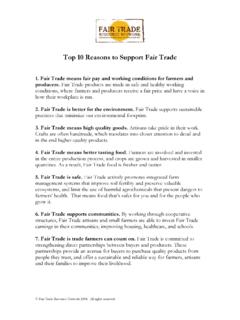
![Some Fair Trade Recipes[1]](/cache/preview/3/9/f/c/4/c/f/4/thumb-39fc4cf45d46ae3b81892de3698202c4.jpg)


